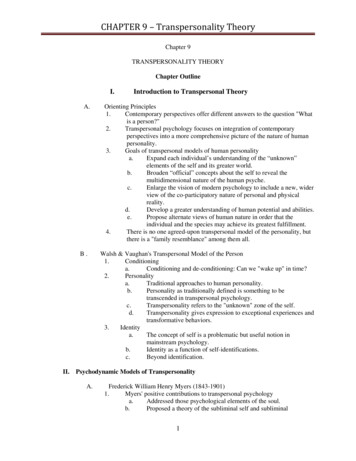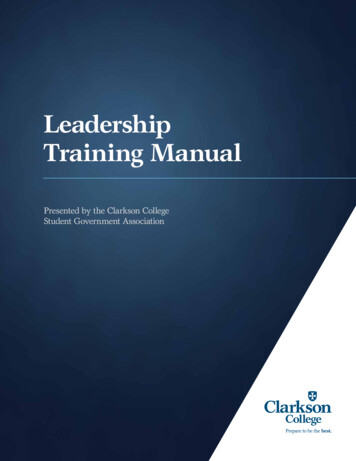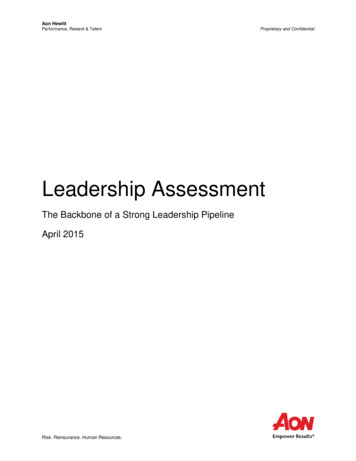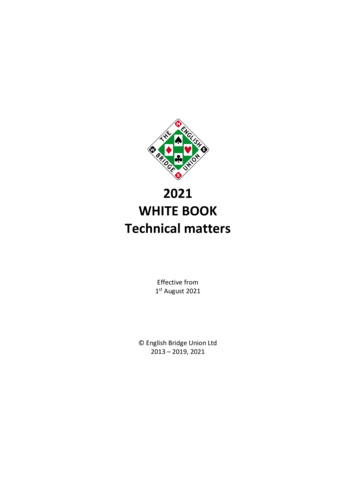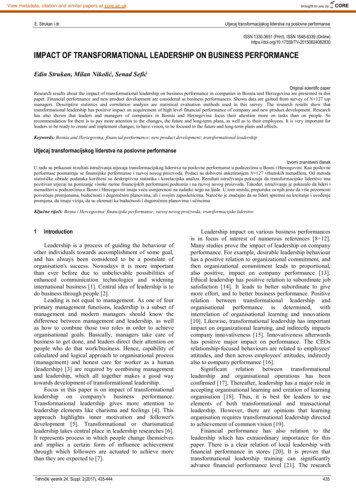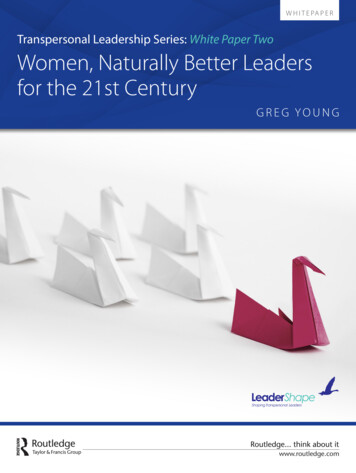
Transcription
W H I T E PA P E RTranspersonal Leadership Series: White Paper TwoWomen, Naturally Better Leadersfor the 21st CenturyGREG YOUNGLeaderShape Corporate GuidelinesColours:Blue (Reflex) 100% Cyan, 100% Magenta.Aqua 63% cyan, 33% yellow.Light Blue 100% Cyan.LeaderShape Green 100% Cyan, 50% Magenta, 50% Yellow.Red 100% Magenta, 100% Yellow.Avoid using black and use red minimally, lots of white space.Reflex Blue (100% Cyan, 100% Magenta)Gradients:100% Blue to 40% Blue.100% Aqua to 30% Aqua.60% Cyan to 20% Cyan.30% Black to 20% Black.Avante Garde Gothic DemiReflex Blue (100% Cyan, 100% Magenta)Fonts:Avante Garde GothicBookBook ObliqueDemiDemi ObliqueMediumMedium ObliqueBoldBold ObliqueShaping Transpersonal LeadersAvante Garde Gothic Book ObliqueAqua (63% Cyan, 33% Yellow)Avante Garde Gothic Book ObliqueReflex Blue (100% Cyan, 100% Magenta)Shaping Transpersonal Leaderswww.routledge.com
WOMEN, NATURALLY BETTER LEADERS FOR THE 21ST CENTURYTRANSPERSONAL LEADERSHIPRoutledge and LeaderShape Global in partnership are pleased to announce a series of quarterlyWhite Papers around the subject of Transpersonal Leadership, culminating in the publication of abook entitled “Becoming a Transpersonal Leader” in January 2018.So what is Transpersonal Leadership? The concept was first published in a report on tomorrow’sleadership, based on a leadership development journey developed by LeaderShape (Knights,2011). The word “transpersonal” was inspired by the use of the word in “transpersonal psychology”(Bynum, 2010). “Transpersonal” is defined as “extending or going beyond the personal orindividual, beyond the usual limits of ego and personality”.A Transpersonal Leader is defined as:They operate beyond the ego while continuing personal development and learning. They areradical, ethical, and authentic while emotionally intelligent and caring.They are able to:LeaderShape Corporate GuidelinesColours:Blue (Reflex) 100% Cyan, 100% Magenta.Aqua 63% cyan, 33% yellow.Light Blue 100% Cyan.LeaderShape Green 100% Cyan, 50% Magenta, 50% Yellow.Red 100% Magenta, 100% Yellow.Avoid using black and use red minimally, lots of white space. embed authentic, ethical and emotionally intelligent behaviours into the DNA of theorganisation build strong, collaborative relationships, and create a Performance Enhancing Culture that is Ethical, Caring and SustainableGradients:100% Blue to 40% Blue.100% Aqua to 30% Aqua.60% Cyan to 20% Cyan.30% Black to 20% Black.Reflex Blue (100% Cyan, 100% Magenta)Avante Garde Gothic DemiReflex Blue (100% Cyan, 100% Magenta)Fonts:Avante Garde GothicBookBook ObliqueDemiDemi ObliqueMediumMedium ObliqueBoldBold ObliqueShaping Transpersonal LeadersAvante Garde Gothic Book ObliqueAqua (63% Cyan, 33% Yellow)Avante Garde Gothic Book ObliqueReflex Blue (100% Cyan, 100% Magenta)Shaping Transpersonal ape.biz/presenting-leadershaperFor permission to reproduce this Whitepaper for educational purposes, please contact Helent Clements, helen.clements@tandf.co.uk.1
WOMEN, NATURALLY BETTER LEADERS FOR THE 21ST CENTURYWomen, Naturally the Best Leadersfor the 21st CenturyBy Greg YoungThis is our second White Paper, entitled “Women, Naturally Better Leaders for the21st Century” and written by Greg Young. This important and timely topic follows the firstvery popular White Paper published in this series on the subject of “Ethical Leadership: How toDevelop Ethical Leaders” which is a fundamental component of Transpersonal Leadership.This second White Paper takes a look at the reasons why we have a confluence of women playinga greater role on the world stage in the workplace and the reasons behind some of the culturalbarriers that hitherto have kept them from achieving parity at the most senior levels. It goes onto reveal new data built around Emotional Intelligence attributes and comparing strengths ofmen and women. The areas where women emerge as stronger are those required by leaders oforganisations to be most successful in the 21st century. It then goes on to present some practicalinput on how to develop organisations that recognise those strengths and to help womendevelop in areas where they are often naturally weaker than their male ction:History is awash with examples of famous leaders that when asked onecan bring to mind. Ask the question specifically whether one can namea notable woman leader and the task still gets more challenging. Theresponses might include female monarchs Cleopatra, Elizabeth 1, Victoria,or politicians Golda Meir, Margaret Thatcher or Aung San Suu Kyi. Take ita step further and ask the question relating to notable woman businessleaders and I am guessing that you will really struggle.“Is it just a coincidence or a real sign ofthe future that as this paper is publishedwe are probably on the verge of womenleading the three most powerful nationsin the Western world?”But is it just a coincidence or a real sign of the future that as this paper is published we are probablyon the verge of women leading the three most powerful nations in the Western world? Angela“Mutti” Merkel, the leader of Europe, has been the German Chancellor since 2005. A pragmaticleader with a relatively low ego and a strong sense of duty has now been joined by the newlyappointed British Prime Minister, Theresa May who had been the UK Home Secretary for 6 yearsand is known for just getting on with the job and avoiding celebrity, but also having that senseof duty. And in November, the polls suggest the first female president of the USA will be elected.It is said Hillary Clinton would become the most experienced President in history when electedin terms of prior government office. What a trio – and can they change the world for the better?For permission to reproduce this Whitepaper for educational purposes, please contact Helent Clements, helen.clements@tandf.co.uk.2
WOMEN, NATURALLY BETTER LEADERS FOR THE 21ST CENTURYFor much of the time leading up to the 20th century women had far bigger challenges toovercome like the basic right to vote, a challenge that continues in some parts of the world. In myparent’s generation, when a woman married, she was usually expected to give up work becauseher place was to run the home, bring up a family and attend to the needs of her husband.Generally, this meant that women did not have careers; they had jobs, something that wouldprovide some level of personal income. When married, this also implied that the household couldbe funded solely based on the income on one earner, the man.In the latter stages of the 20th century this all began to change, though primarily in Europe, NorthAmerica and Australasia, beginning with the international woman’s liberation movement of the1960’s which campaigned for legal and social equality for women. It continues with both thefeminist and post-feminist movements into the 21st century that seek equality in pay, workingpractices and financial self-reliance. Along the way, social norms changed and even became arequirement that in any partnership, both parties need to work in order to generate income for adesired lifestyle. The price of housing has been a major factor.Since the 1980s, around the world more and more women have enteredthe workplace, in Australia according to the Australian Bureau of Statistics,it has increased over 27% since 1978, in Canada women in 2016 represent47.2% of the total labour force, compared to 37.1% in 1976. Many of thesehave careers in mind, ones that will provide pathways to promotion, toincreased income and parity with male colleagues.“Men on the other hand have beenaccustomed to an almost exclusive maleenvironment for centuries.”Men on the other hand have been accustomed to an almost exclusive male environment forcenturies. Where women were present it was to fulfil a supporting function such as that ofsecretary or assistant. Men who began their careers in the 1980s are not only still in the workplace,having progressed up the career ladder, they now occupy the top jobs. Their attitudes carryweight and power and inform their inbuilt or unconscious bias.The business environment is materially changing from the economics of the ‘80s and ‘90s. 20thCentury methods are beginning to struggle in this 21st century world. Reviewing the contentof MBAs, leadership development programmes and philosophies right up to the end of the lastcentury shows that the fundamentals of accepted business practice was based on competition.This informed vision, strategy, strength, power and decision-making. Companies were built likemachines with each part fulfilling its own function, mechanical raw material in, product out; atrue reflection of the Industrial Revolution. The business environment in the 21st century requiresbusinesses to be nimble and agile, both responding to rapid change and capable of anticipatingwhat the next shift will be. They need to respond to complex, wicked problems with systemicsolutions. Business leaders who will be successful will be those who can ride the wave of thisincreasingly changing world, harnessing the benefits of globalisation, technology and newsocietal attitudes to ethics and fairness. They will embrace collaborative relationships and beprepared to be radical in their thinking to build organisations that are fleet of foot and thriveon uncertainty and ambiguity. These leaders will operate beyond their ego, continuing personaldevelopment and learning. They will be able to: Embed authentic, ethical and emotionally intelligent behaviours into the DNA of the organisation Build strong, empathetic and collaborative relationships within the organisation and withall stakeholders Develop a performance-enhancing culture that provides sustainabilityFor permission to reproduce this Whitepaper for educational purposes, please contact Helent Clements, helen.clements@tandf.co.uk.3
WOMEN, NATURALLY BETTER LEADERS FOR THE 21ST CENTURYWe call people that can do this Transpersonal Leaders.What relevance has this to Women in Leadership? A preliminary review of LeaderShape’s researchdata (Knights, 2013) - see section “Where are the Differences in Leadership between Men andWomen?” later in this document - indicated that women are naturally better leaders for the 21stCentury. This view is supported by a broad ranging global study by Mercer (2015 Preliminary)entitled ‘When Women Thrive’.More and more companies now recognise that collaborative, rather than competitive behaviourcreates more success and as such women are well placed to lead in this century. The datashow women have all the right attributes including empathy, change catalyst and inspirationalleadership. More than that, there are a number of reports (Cranfield, 2016) that demonstrate thatcompanies with women on the Board perform better. There are now women on the Board ofevery UK FTSE 100 company. This sounds great, but the 2016 Female FTSE“More and more companies nowBoard Report (Cranfield, 2016) is typical in showing that out of 279 femaleheld directorships, only 26, that’s a mere 9.7% are executive roles so one recognise that collaborative, rather thancould argue the real power is still being controlled by the men. An updatecompetitive behaviour creates moreof the report, fresh off the press in July 2016 shows that the percentage ofsuccess and as such women are wellwomen on the Boards of FTSE 100 companies has risen to 26%, significantlyplaced to lead in this century.”more than the 23.5% recorded in March 2015 but virtually the same as thatwhich the Davies closing report (Davies, 2015) noted in October 2015. More worrying is that thepercentage of women in executive directorships on FTSE 100 Boards has stalled at 9.7% sinceOctober 2015 when it was 9.6%.Representation of women on Boards in the USA is 19.9% of Board seats in the S&P 500 whichcompares to 19.6% on UK FTSE 250 boards. In India, data from Deloitte (Deloitte, 2015), showswomen only hold 7.7% of Board seats in India compared to 12% globally. In contrast the shareof women on Boards in Norway stands at 37% (World Economic Report, 2013), edging closer totheir statutory target of 40%.Clearly, men play a big part in women getting the real power in companies. The enlightenedones recognise and embrace the strength and diversity of qualities and opinion women bring.Yet others steadfastly cling on to the old ways harking back to when they were successful – butin a different context, on another day. Some sectors are worse than others;a recent report (Zarya, 2016) showed that 1 in 3 Technology CEOs don’t“Technical expertise is ROI positive,think gender diversity is important. Congratulations to the 38% of thosepotentially mission critical – necessarythat do but the remainder do not. According to the report, most Techbut insufficient. What will keep theCEOs rate a specific expertise very or extremely important. Fact is, they’recompany ahead is thought diversity.”just not getting it. Technical expertise is ROI positive, potentially missioncritical – necessary but insufficient. What will keep the company ahead isthought diversity. So, having women on your Board and exploiting that thought diversity is whatwill give you a company that will be around in the longer term. Having women on the Board astokenism merely adds talking ballast to the payroll.It’s no secret then that there is resistance from some men to welcome women into the powerfulpositions in senior leadership, but actually that’s not all. Women themselves can be their ownworst enemy. LeaderShape’s data (explained in the next section of this document) show thattwo areas where women don’t score as well as men are self-confidence and emotional selfcontrol. The LEIPA tool, which is based on a 360 format really shows this well. The instrumentcompares observed behaviour against ideal, so the closer to ideal you are observed, the betterFor permission to reproduce this Whitepaper for educational purposes, please contact Helent Clements, helen.clements@tandf.co.uk.4
WOMEN, NATURALLY BETTER LEADERS FOR THE 21ST CENTURYyou are performing. We find that women consistently mark themselves poorly, so their self ratingshows them to be pretty poor performers across all the EI competencies. But being a 360 format,when they see the scores that colleagues have given them, their hidden“It seems to be a real issue that womenstrengths (determined by the difference between their own scores andwill naturally undermine their ownthat of their colleagues) shine out and are usually manifold. This in itselfcan be incredibly reaffirming, but it seems to be a real issue that women achievements, are afraid of being foundwill naturally undermine their own achievements, are afraid of being found out and suffer from imposter syndrome.”out and suffer from imposter syndrome.Where are the differences in leadershipbetween men and women?Between the years 2006 and 2013, LeaderShape undertook some original research usingits executive development tool LEIPA (Leadership and Emotional Intelligence PerformanceAccelerator). Based on a 360 assessment format, LEIPA collects anonymous input fromindividuals, their managers, peers, reports and others with whom they have a meaningful workingrelationship. The questionnaire compared observed against desired frequency of exhibitedbehaviours for all the Emotional Intelligence (EI) competencies set out in Goleman’s model of EIand leadership styles (Goleman, 2002). Data from 161 individuals were assessed, 40% of whichincluded women as the subjects. Ethnicity was not recorded, but all subjects were UK based atthe time of the assessment and the leaders were drawn from across the private, public and notfor-profit sectors.Although LeaderShape did not set out to focus on gender as a leadership issue, subsequentanalysis of the data comparing results from men with that of women indicated some interestingsimilarities and differences.The four EI Competencies of Self Awareness, Self-Management, Social Awareness and RelationshipManagement, were broken down into a number of EI Capabilities.Three other capabilities (Trustworthiness, Communication, and Conscientiousness) were alsoassessed which are considered EI capabilities by some authors but not others but are consideredto be fundamental to good leadership performance.Data and analysisAbsolute Level of Observed & DesiredThe LEIPA survey comprises 92 statements which describe granularbehaviours such as “Behaves calmly under stress” or “Identifies opportunitiesand stimulates individuals to develop to their full potential”. They wereasked to rate to which level they currently observe the behaviour (“howoften does this occur now and in the recent past?”) and at which levelthey would desire the behaviour (How often would you like this to occur?)to occur.1Never or Almost Never2Occasionally3Quite Often4Usually5AlwaysFor permission to reproduce this Whitepaper for educational purposes, please contact Helent Clements, helen.clements@tandf.co.uk.5
WOMEN, NATURALLY BETTER LEADERS FOR THE 21ST CENTURYThe difference between observed and desired (The DifferenceIndex) was measured for each individual behaviour which weregrouped into 19 EI Capabilities. As shown in the table to theright, a “Difference Index” score of greater than 0.5 suggestedthe individual might need to improve that particular behaviourand the greater the Difference Index the greater the need forimprovement and development.Comparing the mean Difference Index scores of men againstthose of women showed that women fared better in 15 of the 19Capabilities as shown on the chart below.Difference Between Observed and DesiredPerforming beyond expectation 0Performing at expectation0Performing close to expectation 0 but 0.5May need improvementFrom 0.5 but 1.0Indicates need for changeBetween 1.0 and 1.5Significant shortfall 1.5Emotional Intelligence Capabilities Differences between Women & Men ve difference Women strongerIn the four Capabilities where men scored better were Emotional Self-control, Self-confidence,Accurate Self-Assessment and Adaptability (although the last one is not statistically significant).The key EI Capabilities where women scored best included ServiceOrientation and Developing Others but also Change Catalyst, Transparency,“Women fared better in 15 of theEmpathy and Inspirational Leadership.19 Capabilities.”Although women scored better than men in other capabilities too, theresults were not significant.For permission to reproduce this Whitepaper for educational purposes, please contact Helent Clements, helen.clements@tandf.co.uk.6
WOMEN, NATURALLY BETTER LEADERS FOR THE 21ST CENTURYDifference Index ScoresE.I. COMPETENCIES / CapabilitiesColour Coding -0.10MALEFEMALEDifferenceSOCIAL AWARENESS0.590.520.070.01 to 0.04RELATIONSHIP MANAGEMENT0.690.620.070SELF MANAGEMENT0.490.490-0.01 to -0.04SELF AWARENESS0.580.62-0.04-0.05 to 0.09Service orientation0.50.380.12 0.1Developing others0.820.710.11Change y0.830.760.07Inspirational Leadership0.690.630.07Achievement ct 4Trustworthiness:0.350.310.04Team work and nisational awareness0.450.410.04Building nal Self ty0.50.53-0.04Accurate Self-Assessment0.60.66-0.05Self Confidence0.50.6-0.1Emotional Self control0.410.57-0.16Sorted According to WOMEN’s Strengths0.05 to 0.09The table above shows the four EI Competencies and the 19 EI capabilities and the three othercapabilities. It shows the EI Competencies and Capabilities in the order of female strengths. Thebiggest differences can be seen to be with Service Orientation and Developing Others withChange Catalyst, Transparency, Empathy Inspirational Leadership, Achievement Orientation andInfluence following behind in close order. Women fare less well than men in four EI Capabilitiesbeing, Adaptability, Accurate Self-Assessment, Self-Confidence and Emotional Self-control.For permission to reproduce this Whitepaper for educational purposes, please contact Helent Clements, helen.clements@tandf.co.uk.7
WOMEN, NATURALLY BETTER LEADERS FOR THE 21ST CENTURYWe explored the data at the level of individual behaviours; in particular, we looked at the behavioursassociated with the best two Capabilities for women compared to men, Service Orientation andDeveloping Others, and the two worst Emotional Self-control and Self-confidence.Components of S E R V I C E O R I E N T A T I O NWe can see the relative Difference Indices of men (dark blue) and women (turquoise) for the fourbehaviours that make up the EI Capability of Service Orientation. We can see the behaviour withthe largest difference (shown by the blue box) “Has an orientation towards serving others” is thelargest single difference between men and women.Components of D E V E L O P I N G O T H E R SLooking more closely at the behaviours associated with Developing Others we can see the relativeDifference Indices of men (dark blue) and women (turquoise) for the four behaviours associatedwith the EI Capability of Developing Others. We can see the behaviour with the largest difference(shown by the blue box) “Identifies opportunities and stimulates individuals to develop to theirfull potential” is the largest single difference between men and women within this EI Capability.These are strengths that women can build on and where men should perhaps focus their owndevelopment.For permission to reproduce this Whitepaper for educational purposes, please contact Helent Clements, helen.clements@tandf.co.uk.8
WOMEN, NATURALLY BETTER LEADERS FOR THE 21ST CENTURYComponents of E M O T I O N A L S E L F C O N T R O LLooking at the behaviours associated with those EI Capabilities where women score less well thanmen, we note they are Emotional Self-Control and Self Confidence. We can see the behaviourwith the largest difference (shown by the blue box) “Behaves calmly when under stress” is thelargest single difference between men and women.Components of S E L F C O N F I D E N C ELooking at the behaviours associated with the EI Capability of Self-confidence, the behaviourwith the largest difference (shown by the blue box), “Confident in own abilities”, was the largestsingle difference between men and women within this EI Capability.These are strengths that men can build on and which indicates an area of personal developmentwhere women might focus for improvement.The final analysis looked at how men and women rated themselves (self-analysis) compared tohow their raters evaluated them. On average, both men and women rated themselves to havea greater difference between “observed” and “desired” than do their raters, however, the gap waslarger (0.29 against 0.15) for women. Although this could be attributed to poor self-assessment,For permission to reproduce this Whitepaper for educational purposes, please contact Helent Clements, helen.clements@tandf.co.uk.9
WOMEN, NATURALLY BETTER LEADERS FOR THE 21ST CENTURYit may also be associated with low self-confidence. During theSelf (Difference) Male Vs Femalefeedback process, it is not uncommon for this picture to be aMaleFemaleDifferencerevelation to the candidate in understanding how others see herin contrast to how she sees herself. This mirrors the commonly felt0.150.29-0.15imposter syndrome. In contrast, being presented with anonymousand therefore less biased data on her own performance that isconsiderably better than her own assessment provides a very positive and reaffirming boost toself confidence that often equates to a mandate to do more of the same.Ensuring women reach the top:There are many strong and valid societal and organisational reasons why fewer women reachsenior positions and the very top of organisations than would be expectedand justified by demographics. What this research study identifies is“During the feedback process, it isthat women are actually better than men as leaders in many of the EInot uncommon for this picture tocapabilities that make up the leadership styles that leaders need in thebe a revelation to the candidate in21st century.understanding how others see her incontrast to how she sees herself.”However, the study also shows that there are a few areas, especially aroundemotional self-control and self-confidence where women could andshould focus to make themselves as good as they can be as leaders in this fast changing world.Strategies for building a strong pipeline ofwomen leadersThis study shows that woman have natural attributes that when realised make them idealleaders for organisations in the 21st century. The challenge however, is to get more women intoleadership positions where they can deliver maximum advantage.These strategies fall into broad categories of:1. Setting targets based upon sound data2. Creating the right HR policies that enable the talent to be present in the work environment3. Developing Organisation Development (OD) policies that recognise the difference in requirementsbetween genders.4. Building a culture that recognises and encourages leverage of the difference that woman canmake to strategic thinking and performance.Setting targetsWhile the debate about gender quotas continues, and 15 countries globally have adopted them(Terjesen, 2016), others, including the UK have adopted a voluntary business-led approach.Targets provide clarity of goals and a disciplined approach to change. They should be set in theFor permission to reproduce this Whitepaper for educational purposes, please contact Helent Clements, helen.clements@tandf.co.uk.10
WOMEN, NATURALLY BETTER LEADERS FOR THE 21ST CENTURYcontext of a clear action plan, with a specific timeline and a robust measurement process toidentify progress. Target setting in this way is a manifestation of vision and a clear communicationboth internally and externally that the organisation seeks to shift. However, targets should not beset only for the highest level, say at Board level, they should be set to build a strong successionpipeline of talented women. This might include setting proportionality in the promotions process,processes that are designed to minimise unconscious bias. So say if 40% of the available talentpool comprises women, then it would be expected that roughly 40% of staff promoted to seniorpositions from that pool would be women, reflecting the available pipeline.Creating the right HR policiesMercer’s global study ‘When Women Thrive’ (Mercer, 2015) demonstrates that policies such as payequity and health and benefit programmes impact firms’ long term ability to engage and retainfemale talent. According to the World Economic Forum (2015), women today earn what menwere earning ten years ago with global average earnings for women being 11k compared to 21k for men. This is sometimes a matter of unintended“Women today earn what men wereconsequences, for example, an organisation whose culture is equallyearning ten years ago with globalsupportive of men having time off options for family and paternity leaveaverage earnings for women being 11kare better situated to improve the representation of women. When mencompared to 21k for men.”take time off for family reasons, this can release the woman to be in workand participate in the talent pool and improve chances of promotion. InSweden, parents are entitled to 480 days leave (until the child is 8 years old) of which the fathermust take at least 90 days. In fact, the fathers take closer to 120 days (Swedish Gov., 2016) payequity means that men’s roles are less likely to be prioritised over women’s for those familiesrequired to maximise income to support a burdensome mortgage.Reframing OD policyMost organisations’ Organisation Development (OD) policies are remnants of the 20th century,naturally favouring a male approach to job application and promotion. Women often approachmatters in a different way; it often being said that a man will look at a job application and think‘I can do 20% of that, I think I will apply’ and a woman will think ‘I cannot do 20% of that; I don’tthink I can apply’.Case study:In the ‘90s I was on a panel of employees asked to undertake some research by aparticularly enlightened General Manager. The context was a Pharmaceutical company,in particular the sales function. It was noted that at the Sales Representative level, themajority of the employees were women, around 75%. At Territory Management level, thisproportion went down to 50% women; at Regional Management level, the percentageof women was 25%. The National Sales Manager was, and has always been a man, neitherhad there ever been a woman on the Executive Team. The task was to find out why thiswas so and to create an environment where women could be better represented athigher levels in the organisation.For permission to reproduce this Whitepaper for educational purposes, please contact Helent Clements, helen.clements@tandf.co.uk.11
WOMEN, NATURALLY BETTER LEADERS FOR THE 21ST CENTURYWe undertook a series of interviews and observed:1. Women made successful sales representatives, at least as good as the men.2. Where women were in leadership and management roles, their teams performedas well as those reporting to male managers.3. Some women eliminated themselves from career progression because they left onmaternity leave and elected not to return (within the period of the study).4. Some women had no ambition to seek promotion, this number was similar to thatof men.5. Some women had a desire for promotion but did not put themselves forward.6. Some women sought promotion, but were unsuccessful.7. A small number of women sought promotion and were successful.Digging a little deeper we found that of those in the last three observations:1. Some women did not feel they had the skills to
Century methods are beginning to struggle in this 21st century world. Reviewing the content of MBAs, leadership development programmes and philosophies right up to the end of the last century shows that the fundamentals of accepted business practice was based on competition. This informed vision, strategy, strength, power and decision-making.
